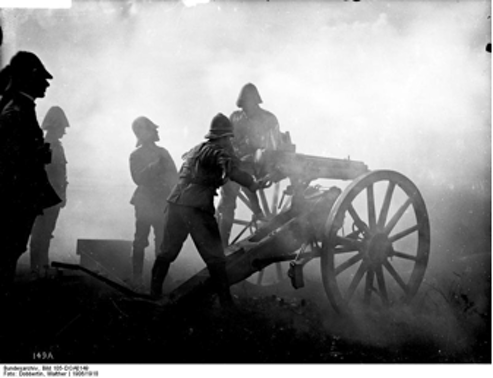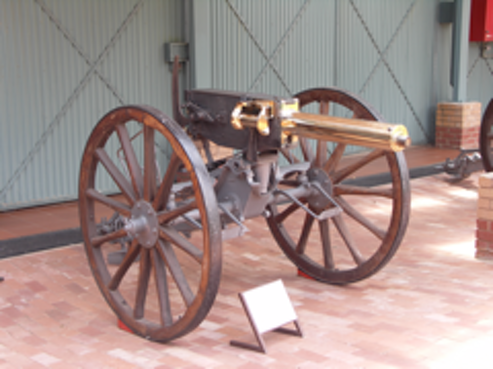The following is an excerpt from the upcoming historical scenario and rules book The Herero War:
The Revolverkanone

Revolverkanone in German East Africa
The Revolverkanone (Revolver cannon) was a shipboard, Gatling-gun type cannon. The 37mm-Hotchkiss-Kanone (37mm Hotchkiss Cannon) was developed by the French firm Hotchkiss et Cie (founded and run by American engineer Benjamin Berkeley Hotchkiss). It was used by the French, German, and other European navies. The Revolverkanone had 5 barrels, and fired high-explosive shells that were between 0.625 and 0.675 kg (1.38 to 1.49 pounds). Its rate of fire was on the order of 30 to 40 rounds per minute (tending towards the higher end when used on land).
Several Revolverkanonen were removed from the SMS “Habicht” to be used on land. They were employed as garrison defense weapons and, more importantly, as an artillery support weapon for the Landungskorps as it advanced along the Swakop.
The Maschinenkanone

A 37mm Maschinenkanone M97, captured in 1915 in
German South-West Africa during World War One.
The Maschinenkanone (Machine cannon) was an autocannon employed by the Marines. The 37mm Maschinenkanone M97, produced by Krupp, was simply a German version of the “Pom-Pom” gun used by numerous powers in the late 19th and early 20th centuries. It is more widely known as the 37mm Maxim-Nordenfelt gun, and was made famous when employed by the Boers during the Second Anglo-Boer War. The original design was created by American Hiram Maxim in the 1880s. It was essentially a machine gun that had been modified into a longer-range machine cannon firing explosive shells (0.4 kg or approximately 1 lb) instead of bullets.
Despite their relatively rapid rate of fire, the Revolverkanone and Maschinenkanone were not particularly effective at inflicting casualties against expertly concealed Hereros in well-fortified positions. The real tactical value of these multiple-shot artillery pieces was in providing suppression:
“…Die Wirkung der 3,7 cm Granaten (Maschinen- und Revolverkanonen) war gegen den Gegner in den “Klippen” wohl nur gering, immerhin genügte sie, das feindliche Feuer niederzuhalten.” (Marine-Expeditionskorps, pg. 74)
“The effect of the 37 mm shells ( [both] Machine cannon and Revolver cannon ) against the enemy in the cliffs was no doubt only negligible, nevertheless it was sufficient to suppress enemy fire.” (Translation by Roy Jones)
MAIN GERMAN SOURCES
The "Marine-Expeditionskorps" referenced in the excerpt above is the official history of the Marines during the Herero War. The main sources on the employment of Revolverkanonen and Maschinenkanonen are the Marine official history and the official history of the Landungskorps ("Landing Corps", or naval landing party) from the gunboat SMS “Habicht” (i.e., His Majesty's Ship "Hawk"). Both sources are listed below:
Die Tätigkeit des Landungskorps S.M.S. "Habicht" während des Herero‑Aufstandes in Süd‑West‑Afrika, Januar/Februar 1904 Auf Grund amtlichen Materials bearbeitet im Admiralstab der Marine (The Actions of the Landing Corps (Naval Landing Party) of His Majesty’s Ship “Hawk” during the Herero Revolt in South-West Africa, January/February 1904, based on official materials arranged by the Admiralty Staff of the Navy); Berlin, Ernst Siegfried Mittler und Sohn, 1905; (hereafter, Landungskorps)
Marine-Expeditionskorps in Südwest-Afrika während des Herero-Aufstandes Auf Grund amtlichen Materials bearbeitet im Admiralstab der Marine (The Marine Expeditionary-Corps during the Herero Revolt, based on official materials arranged by the Admiralty Staff of the Navy); Berlin, Ernst Siegfried Mittler und Sohn, 1905; (hereafter, Marine-Expeditionskorps)